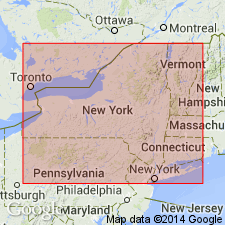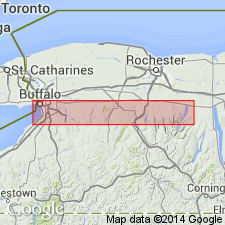
- Usage in publication:
-
- Lakeview Bed
- Modifications:
-
- First used
- Dominant lithology:
-
- Shale
- AAPG geologic province:
-
- Appalachian basin
Summary:
"NAUTILUS Bed" of Grabau (1899) will be renamed Lakeview Bed by Miller (in press) for excellent exposure near town of Lakeview in western NY. Bed is assigned to Darien Center Submember of Wanakah Shale Member of Ludlowville Formation and lies above the newly named Girdle Road Bed. Described as a prominent concretionary horizon that overprints a complex amalgamated shell bed at the base of a very fossiliferous interval of gray calcareous shale. Fauna is highly diverse and includes brachiopods, trilobites, bryozoan, crinoids, and corals. At several localities, the Lakeview underlies the Darien Coral Bed of Kloc (1983: MA thesis). Age of the Wanakah Shale Member and its beds is Middle Devonian.
["Submember" not recognized as a formal stratigraphic rank term (CSN, 1933; ACSN, 1961, 1970; NACSN, 1983, 2005). Considered informal until formally published. The rank or lithologic term should not be capitalized.]
Source: GNU records (USGS DDS-6; Reston GNULEX).

- Usage in publication:
-
- Lakeview Bed
- Modifications:
-
- Named
- Dominant lithology:
-
- Mudstone
- AAPG geologic province:
-
- Appalachian basin
Summary:
Lakeview Bed of Darien Center Submember of Wanakah Member of Ludlowville Formation here named for town of Lakeview on Lake Erie shore. Excellent, closely spaced stream-bank exposures of the Darien Center Submember at the base of the Wanakah occur throughout most of the study area from the Lake Erie shore to Hopewell Gully, east of Lake Canandaigua in Ontario Co, a distance of more than 100 km. Submember represents a regressive-transgressive cycle with a nearly symmetric pattern of storm bed types and faunal assemblages, including the Mt. Vernon Bed, which marks the base, and the ascending Lakeview, Darien Coral, Murder Creek, and Bidwell beds discussed in this report. Lakeview Bed marks the base of Taphofacies V.
["Submember" not recognized as a formal stratigraphic rank term (CSN, 1933; ACSN, 1961, 1970; NACSN, 1983, 2005). Considered informal until formally published. The rank or lithologic term should not be capitalized.]
Source: GNU records (USGS DDS-6; Reston GNULEX).
For more information, please contact Nancy Stamm, Geologic Names Committee Secretary.
Asterisk (*) indicates published by U.S. Geological Survey authors.
"No current usage" (†) implies that a name has been abandoned or has fallen into disuse. Former usage and, if known, replacement name given in parentheses ( ).
Slash (/) indicates name conflicts with nomenclatural guidelines (CSN, 1933; ACSN, 1961, 1970; NACSN, 1983, 2005, 2021). May be explained within brackets ([ ]).

